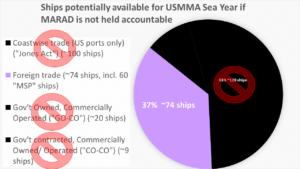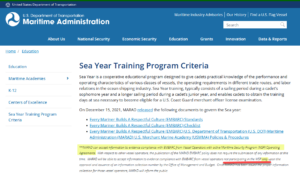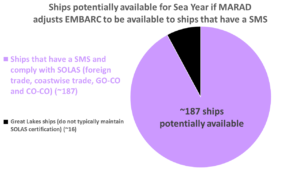Today’s post is an exposé on how MARAD has begun the deliberate dismantling of USMMA’s Sea Year. In a follow up post, we will explore MARAD’s motive for harming the world’s premier merchant marine training institution and who benefits from its insidious actions. In the first part of this series, I explained what was meant by Sea Year aboard a commercial ship and the four basic categories of U.S. flag, commercial ships that Academy midshipmen have traditionally sailed upon in their Sea Year:
All of the ships in these four categories (presently totaling 203 vessels) used to be available to Academy midshipmen for Sea Year. Unfortunately, MARAD’s EMBARC rule is intended to make most of these ships off limits to Academy midshipmen. If MARAD is allowed to get away with its gamesmanship, this is what that the universe of possible commercial ships available to Academy Midshipman will look like:
I don’t lightly make the claim that MARAD is intentionally doing this. Let me prove it to you.
First, let’s step back to when MARAD released EMBARC. At that time MARAD wrote—in very fine, low contrast, print barely visible at the bottom of the EMBARC page—that only the 60 ships in the MSP program were eligible to apply. That meant MARAD told 143 ships not to apply. Here’s a screen capture from MARAD’s website as preserved by the Internet Way Back Machine on December 28, 2021 (click to embiggen).
MARAD has doubled-down on keeping ships out of EMBARC since then.
Now let’s look at the EMBARC proposal that MARAD just published in the Federal Register. If you scroll down to the “Background” section, MARAD tells us
As a prerequisite to employing USMMA midshipmen as cadets aboard their vessels, MARAD expects commercial vessel operators to evidence implementation of EMBARC and to sign the EMBARC Statement of Compliance. [Emphasis added.]
What that means is that if a commercial ship owner does not voluntarily adopt EMBARC, MARAD will not allow midshipmen to sail on those vessels. But, if you scroll down further in the Federal Register, you will find that MARAD has limited the vessels that are eligible to adopt EMBARC but in a much more devious manner than December’s “only MSP ships need apply” statement. Here is what it says: :
EMBARC standards apply to owners and operators of vessels subject to the International Convention for Safety of Life at Sea 1974 (SOLAS). However, MARAD seeks comments and recommendations related to applying EMBARC, or substantially similar standards to vessels not subject to the Convention. [Emphasis added.]
That language—”subject to” SOLAS—was very carefully chosen by MARAD. A ship sailing from any U.S. port to any foreign port is required to adhere to (i.e. “subject to”) SOLAS. Those are the ships shown in lavender in the two graphs above. But here’s the Catch-22: A ship traveling from Houston to New York is not required to adhere to SOLAS. And because it is therefore not “subject to” SOLAS, MARAD won’t let the owner of that ship qualify for EMBARC and therefore that ship is not permitted—by MARAD—to carry Academy midshipman on Sea Year.
But does the ship that is not “subject to” SOLAS fully comply with SOLAS? Absolutely it does. And, if compliance with SOLAS is the standard for eligibility for EMBARC, it makes no sense to eliminate an entire category of U.S. flag commercial ships that are fully compliant with SOLAS simply because they aren’t “subject to” SOLAS. Would it not make sense that if this ship is in compliance with SOLAS (as certified by the USCG or a classification society) that it can take USMMA midshipmen? Absolutely it would – unless the goal is to make sure it never does.
Ostensibly, the reason that SOLAS was selected by MARAD as the vehicle for deploying EMBARC is because SOLAS requires ships to have a “Safety Management System” (“SMS”) into which the vessel’s EMBARC standards can be incorporated. A ship’s SMS is subject to auditing by the U.S. Coast Guard and vessel classification societies such as the American Bureau of Shipping. Using the existence of an SMS to deploy EMBARC makes sense from a bureaucrat’s point-of-view: It lets the bureaucrat “set it and forget it” because someone else will do the auditing for you. And MARAD doesn’t want to do any work it doesn’t have to do.
But, MARAD’s logic doesn’t pass the smell test:
Ships that are “subject to” SOLAS are not the only ships that have SOLAS-compliant Safety Management Systems. In fact, all of the vessels in the charts above (with the exception of 16 Great Lakes vessels that are special cases)—whether “subject to” SOLAS or not—have a SOLAS-compliant SMS because they sometimes do go on voyages (such as to foreign ports) where, by law, they must comply with SOLAS. No vessel owner wants to lose the flexibility of being able to sail foreign by failing to comply with SOLAS.
Yes – all 185+ commercially operated, ocean-going, ships that were used for Sea Year before EMBARC are SOLAS approved and have certified Safety Management Systems in place. But MARAD has deviously removed 63% of them from eligibility for EMBARC and therefore made them unavailable to USMMA midshipmen for their Sea Year.
It’s important to understand that SOLAS is not something that a shipping company can turn off and on depending upon whether or not it is on a foreign voyage. SOLAS has extensive requirements relating to the construction, equipment, and operation of a vessel. We are talking about things like compartmentation of a ship with watertight doors; radio equipment; lifesaving gear; and, yes, a SMS.
A ship is certified as SOLAS-compliant every five years and is subject to inspections by the USCG or a classification society on at least an annual basis. Thus, it doesn’t matter whether vessels “not ‘subject to’ SOLAS” are on foreign voyages; they are still every bit as in compliance with SOLAS as are vessels that only sail to foreign ports. Every one of these “not ‘subject to’ SOLAS” vessels has a SMS system that allows it to be in compliance with SOLAS.
If the criteria for allowing Academy midshipmen on ships is that that the ship have a SMS so that EMBARC can be incorporated into the SMS, then the entire US Fleet (except for the 16 Great Lakers) should be eligible for EMBARC.
If MARAD made one modification to its arbitrary “subject to SOLAS” standard—simply state that any ship with valid SOLAS certificates may apply for EMBARC instead of limiting it to vessels that are “subject to” SOLAS—then it would still accomplish its goal of having EMBARC incorporated in the vessel’s SMS. But look at how it would open up ships for Sea Year:
Now why wouldn’t MARAD do that? Stay tuned to learn why MARAD is trying to destroy Sea Year aboard commercial vessels . . .





So, if their goal it to change the industry relative to SASH on board commercial vessels, wouldn’t what you propose impact more of the industry and have a greater impact on taking SASH on in the industry ?
Keith, what I propose would have a HUGE and favorable impact upon the Academy’s Sea Year. But, to answer your question, allowing the entire ocean-going US Flag fleet to be eligible to adopt EMBARC is likely to have mariginal, at best, impact for taking on SASH in the industry — because MARAD is the wrong agency to be trying to address SASH in the first place. MARAD has no regulatory authority over the industry. The little influence it has is related to USMMA’s Sea Year. If shipping companies don’t voluntarily adopt EMBARC, their “penalty” is to not have USMMA midshipmen assigned to their vessels. That’s it. That’s the only penalty. Even if they do adopt EMBARC, the SASH protections, while having some overall impact on the operations of the ship, are primarily geared towards protections for midshipmen. In essence, while the concept behind EMBARC may be well-intentioned, it is an ineffectual program at best with no teeth behind it.
There are a couple of issues here. First, if we are truly going to address SASH on an industry-wide basis, then the agency that has enforcement power over the industry and the credentials of the people working in the industry–the USCG–needs to be the lead agency. Second, we need to recognize and address the fact that SASH and alcohol abuse are very closely entwined. Approximately one-half of all sexual assaults (nationwide, not just in this industry) involve a male perpetrator who has been consuming alcohol; moreover, approximately one-half of all sexual assaults involve a victim who has been consuming alcohol. Source. As this blog has stated in the past, to truly address SASH, it is critical to address the alcohol component. And once again, the agency best suited for dealing with alcohol abuse on ships is the USCG.
As a recent graduate of Kings Point, the largest reason that I was able to get a third mate job on a coastwise tanker immediately after graduation was because of the ability to earn my PIC during my sea year on a COMMERCIAL vessel. Ask any recent graduate, the ones who were able to sail immediately as a third mate (which should be the goal of any maritime school) were ones with a PIC. Especially with the funding for a new Tanker Security Program for the next fiscal year (adding 10 new tankers to the American-Flag fleet), the opportunities for upcoming graduates with their PIC is only going to increase in the coming years. By gaining a PIC on an MSC ship (Single-Hulled, Large Vessel Crews, No Inert Gas System, Open Gauging, etc), graduates may find even more difficulty in their new job. Due to Stand Down Part II, it is very likely that the classes of 2023/2024 will not have the same opportunities through no fault of their own.
It would be helpful to have MARAD’s comments on these allegations. Why are they doing things like excluding Jones Act ships because of SOLAS?
What would be their purpose for strangling Sea Year?
But this all furthers the argument that the US does not need 6 academies graduating merchant marine officers. As such, KP should be transferred to the Dept of Defense and serve all branches of the military as, e.g. the US Cyber Academy or US Transportation and Logistics Academy.
Answers to your questions are in Part 3, which will be posted shortly. MARAD is welcome to comment and I would post whatever MARAD submitted.
As for the need, the country projects a shortage of merchant marine officers in coming years. What we need is a reserve of Strategic Sealift Officers who will be available in time of war. Every USMMA midshipman graduates as an SSO and thus helps fulfill that need. Only a handful of graduates from each of the state schools come out as an SSO. That’s truly ironic–the federal government is spending $1.5 billion on training ships to get a very weak return on its investment in the form of SSOs.
Bob your comments are spot on as far KP coming under the department of Defense!